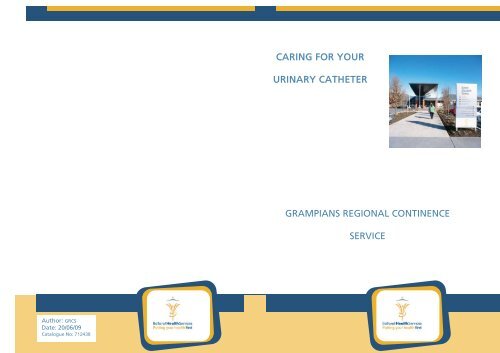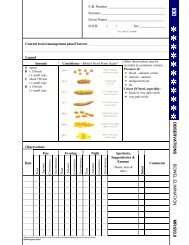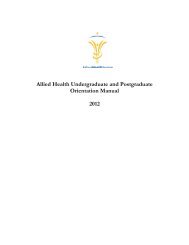Catheter Care brochure - Ballarat Health Services
Catheter Care brochure - Ballarat Health Services
Catheter Care brochure - Ballarat Health Services
You also want an ePaper? Increase the reach of your titles
YUMPU automatically turns print PDFs into web optimized ePapers that Google loves.
CARING FOR YOURURINARY CATHETERGRAMPIANS REGIONAL CONTINENCESERVICEAuthor: GRCSDate: 20/06/09Catalogue No: 712438
What is a urinary catheter?A urinary catheter is a hollow tube which drainsurine from the bladder. The catheter is kept inthe bladder by an inflatable balloon. Yourdoctor or nurse will explain why your catheter isnecessary and the length of time it is required.There are different sizes and brands of cathetersand, depending on the type, they can remain inthe bladder for up to three months withoutneeding to be changed.Where does the urine drain to?The end of the catheter is attached to a drainagebag, which is attached to the leg and collects theurine.Your nurse or doctor will help select the correctsize and type of catheter suitable for you alongwith the most appropriate leg bag, overnightbag or bottle.An alternative to using a drainage bag may be aurine drainage catheter valve but this needs tobe discussed with your doctor or nurse as it maynot be appropriate for you.Where are the GRCS sites located?BALLARAT<strong>Ballarat</strong> <strong>Health</strong> Service - Rehabilitation Centre102 Ascot Street South, <strong>Ballarat</strong> 3350Email: continenceservice@bhs.org.auTelephone: 03 5320 3795Facsimile: 03 5320 3737BACCHUS MARSHDjerriwarrh <strong>Health</strong> <strong>Services</strong>Consulting RoomsTurner Street, Bacchus Marsh 3340Email: continenceservice@bhs.org.auTelephone: 03 5320 3795Facsimile: 03 5320 3737DAYLESFORDDaylesford Community <strong>Health</strong> Centre18 Hospital Street, Daylesford. 3460Email: continenceservice@bhs.org.auTelephone: 03 5320 3795Facsimile: 03 5320 3737ARARATEast Grampians <strong>Health</strong> ServiceCommunity CentreGirdlestone Street, Ararat 3377Email: continenceservice@bhs.org.auPhone: 03 5352 9327 - 03 5320 3795
Future supply of catheters anddrainage bag/ bottleName:<strong>Catheter</strong> brand:<strong>Catheter</strong> size:Frequency of catheter change:Routine catheter changes will be performed byContact details:Leg bag brand:Leg bag capacity:Overnight drainage:Other equipment:Supplier:A&EP CAASDVA LinkagesOtherContact details:Name:Telephone:Continence Nurse:Leg urinary drainage bagA drainage bag can be attached to your upperthigh or calf to collect the urine and gives youfreedom of movement.The tubing on the bags can vary in length, so itis important for your comfort that the mostappropriate one has been chosen.There are different capacity leg drainage bags,the most common being 500 mls and 750 mls.Due to the capacity, the drainage bag willrequire frequent emptying.The drainage bag needs to be secured to yourthigh or calf with Velcro straps, or an alternativesuch as Leggifix. You can discuss these optionswith your nurse to ensure the most appropriateway to conceal it under your clothes.Overnight, a larger capacity bag (2 litres) ordrainage bottle (4 litres) can be attached directlyinto the end of the leg drainage bag.Ensure the tap on the leg bag is left opened sothe urine can flow into the larger container.
Caring for your catheterGently wash around the area where the catheteris inserted using warm water with unscentedsoap. A daily shower or bath is recommended ifpossible and dry the area thoroughly with a softtowel.Do not disconnect the leg bag from thecatheter when showering or bathing.Powder or deodorant is not to be used nearcatheter insertion site as it can causecontamination to the catheter leading to aninfection.Ensure the catheter and drainage bag is wellsupported when showering or bathing. Legstraps can stay in position and then be changedto dry straps when dressing.Ensure there is no contamination of the catheterfollowing bowel motions. Always wash yourhands before and after attending to yourcatheter or emptying the drainage bag/bottle.Problem solvingWhat if there is blood in my urine?• A small amount of blood can make theurine look quite red• Increase fluid intake to encourage urinedrainage• If blood persists, report it to your doctor ornurseWhat if there is sediment or debris in myurine?• Ensure an adequate fluid intake to ensurepale, clear urine is draining• Contact the nurse who changes yourcatheter as the catheter may requirechanging if blockage is occurringDoes constipation affect my catheter?• Constipation can prevent the catheterfrom draining• Constipation can cause urine leakagearound the catheter• Ensure a well balanced diet and a goodfluid intake• If constipation is an issue contact yourdoctor or nurse
Problem solvingWhat if there is urine leakage?• Ensure an adequate fluid intake to ensurepale, clear urine is draining• Ensure the tubing is not bent or kinked• If there is obvious debris in the tubing changedrainage bag• Contact the nurse who changes your catheteras the catheter may require changing• Ensure regular soft bowel motionsWhat if the catheter falls out and I can passurine?• Call your nurse in office hours so thecatheter can be reinsertedWhat if the catheter falls out and I can not passurine?• Contact your nurse immediately• If unable to contact, attend emergencydepartment• Ensure to take a new catheter with you incase it requires changingWill my sexual function be affected with thecatheter?• No, the catheter can be taped out of the wayduring intercourse, do not hesitate to discussthis with your nurse or doctor<strong>Care</strong> of the urine drainage bagThe urine can be emptied down the toilet, or intoa container kept only for this purpose, by openingthe outlet tap at the bottom of the drainage bag.Close the outlet tap once the bag has emptied,ensuring not to touch the outlet where the urinedrained from.The drainage bag will need to be changed on aweekly basis and replaced with a new bag.Wash hands and remove the cap from the newdrainage bag. Gently pinch the end of thecatheter to prevent urine leakage and pull/twistthe tubing of the drainage bag to disconnect itfrom the catheter.Slowly push the connector of the new drainagebag into the opened end of the catheter.Secure the drainage bag to your thigh or calf withVelcro straps, or an alternative such as Leggifix.Ensure you wash your hands after attending tothe drainage bag or catheter.
<strong>Care</strong> of the overnight drainage bag/bottleTo attach the overnight tubing, remove the capfrom the tubing and keep the cap so it can beused the following morning when the nighttubing is removed.Slowly and gently push the night bag connectorinto the outlet tap of the leg bag.Always check that the outlet on the nightdrainage bag is closed or the plug in the nightbottle is removed as this will allow for the urineto drain. The nurse can advise you on the mostappropriate night container.The night bag can hang on a stand and thedrainage bottle can stand beside the bed.In the morning, close the outlet tap on your legbag then remove the night drainage system.Empty the drainage bag/bottle and rinse itthrough with warm soapy water.Allow the bag/bottle/tubing to drain thoroughlyfor the next night’s use and store in a clean dryarea. The drainage bag is to be changed weeklyand the bottle/tubing changed as required.Problem solvingWhat if bladder spasms or cramps occur whena new catheter has been inserted?• They usually pass within 24 hours. If theypersist, inform your doctorWhat if no urine drains for several hours?• Ensure an adequate fluid intake to ensurepale, clear urine is draining• Ensure the tubing is not bent or kinked• Reposition drainage bag to ensure it isconnected correctly• Ensure the drainage bag is below bladderlevel• If there is obvious debris discuss with nurseor doctorWhat if no urine drains for an extendedperiod of time and there is abdominaldiscomfort?• Contact your doctor or attend emergencydepartment• Ensure to take a new catheter with you incase it requires changing
















